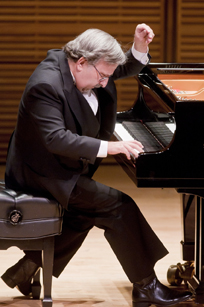Şahan Arzruni, Pianist in Review
Şahan Arzruni, Pianist in Review
The Fund for Armenian Relief Presents: Together for Armenia
A Benefit Concert for the Vanadzor Old Age Home
Şahan Arzruni, Piano, with Adam Rosenblatt, Percussion, and Simon Hagopian-Rogers, Violin
Merkin Concert Hall at the Kaufman Music Center, New York, NY
April 5, 2016
Those who say all piano recitals are alike these days have certainly not heard Şahan Arzruni, at least not his most recent New York recital to benefit a senior’s home in Armenia. One would be hard pressed to find duplication of such an evening anywhere – from the unusual Armenian repertoire to the scholarly, often humorous, commentary which made the evening almost more lecture-recital than recital.
Mr. Arzruni is a passionate Armenian pianist who has dedicated much of his extensive concertizing to promoting cultural awareness of Armenian music and benefitting Armenian charities. He is a persuasive advocate, and one left the hall marveling that this body of repertoire has remained still so largely untapped.
The concert opened with a short piece by Arno Babadjanian (1921-1983), the composer’s doleful Elegy (after Sayat Nova), inspired in 1978 by grief over the death of Armenian composer, Aram Khachaturian. It is an accessible, heart-on-sleeve piece, with some of its brooding harmonies reminiscent of Tango composer Astor Piazzolla (and if that seems a stretch from Armenia to Argentina, it isn’t – Babadjanian did actually compose a beautiful Tango himself and the two musical traditions have had interesting cross-pollination).
The next work was a set entitled Yenovk (in honor of the artist Yenovk der Hagopian) by Alan Hovhaness (1911-2000). Hovhaness was known as an eclectic American composer who delighted in many cultures, but he particularly treasured his Armenian heritage on his father’s side. He was extremely prolific, so maybe it shouldn’t be surprising that we still have not exhausted possible premieres of his works sixteen years after his death, but it was still exciting to hear Mr. Arzruni, who also performed the World Premiere of Yenovk in California in this complete version, now giving the set its New York Premiere. The six movements opened with a Fantasy, rather mesmerizing as a chant projected through repeated notes, and followed with Canzona I, Jhala, Canzona II, Ballata, and Fugue. The set combined folk elements of drone basses, stark unaccompanied solo lines, tremolando effects, and dervish-like frenzies that transported one to an exotic terrain far from Manhattan. Occasionally the journey was interrupted by what seemed some unevenness in the hall piano (which does become a distracting problem with all the balalaika-type repeated notes), but Mr. Arzruni held it all together with impressive command and passionate commitment.
Also by Hovhaness were the Five Invocations to Vahakn (New York Premiere) with Mr. Arzruni joined by percussionist Adam Rosenblatt, who played drums, gongs, cymbals, a thunder sheet, and a conch shell (a fittingly noisy assemblage for Vahakn, god of fire and war). Mr. Arzruni elicited laughter as he gestured to the instruments asking, “what is that?” – an assortment to wake up the most jaded audience – but all comedy aside, these were colorful and dramatic pieces.
Even more remarkable chronologically than the Hovhaness premieres was the World Premiere of music by Kristapor Kara-Mourza (1853-1902), his Potpourri on Armenian Songs (1872). Valuable from a musicological perspective perhaps more than musical, this work of Kara-Mourza was some of the first Armenian music notated for piano. True to a disclaimer by Mr. Arzruni that it is “a piece of kitsch,” it was replete with “urban folk” tunes of an adulterated sort. The medley was nonetheless fascinating in the context of the rest of the program, an important piece of the historic picture.
After Intermission came music by a far more famous Armenian composer, Aram Khachaturian (1903-1978). His Chant-Poème was given a beautiful performance by eleven-year-old violinist Simon Hagopian-Rogers, accompanied by Mr. Arzruni at the piano. One expects prodigies today to dazzle with technical facility, but what was impressive here was the young performer’s grasp of the rhapsodic feeling of the piece. Already performing internationally, this violinist will certainly be a young artist to watch.
With a child performer, exotic instruments, and some comedic touches thrown in, Mr. Arzruni was ready for even the most attention-deficit audience – and yet they were all just the right counterbalance to his serious and detailed scholarship. Exemplifying that scholarship, and of greatest weight on the program, were Khachaturian’s Recitatives and Fugues (World Premiere as a complete set). In 1968 Khachaturian added recitatives to seven fugues he had composed in his younger days and had rediscovered decades later. Similar in format to Preludes and Fugues by any number of composers, the resulting set is a valuable addition to Khatchaturian’s body of piano works. At twenty-five minutes in duration and rather cerebral listening at times, they demand much from an audience, but one couldn’t help observing that Mr. Arzruni had drawn a particularly attentive audience. The pieces reflected some influence of Shostakovich (especially in the giocoso sections, as in number 3), some of Bach (naturally), and even of Rachmaninoff (more in the Recitative sections, especially in number 2), but these works stand on their own and warrant further playing. Mr. Arzruni is to be congratulated for pulling off this very demanding achievement.
To cap off the program Mr. Arzruni fittingly presented Armenian Dances by Komitas (1869-1935), often regarded as the father of Armenian music. These are what Mr. Arzruni called “re-creations” (not compositions exactly, but not arrangements), and they included Yeranki (from Yerevan), Hed ou Arach (from Garin), and Shoror (from Moush). They closed the program with an affirmation of Armenian music’s roots, eliciting an encore of the Nocturne in E-flat, Op. 9, No. 2 by Chopin, an honorary Armenian for the evening. A grateful audience will surely return for more.

